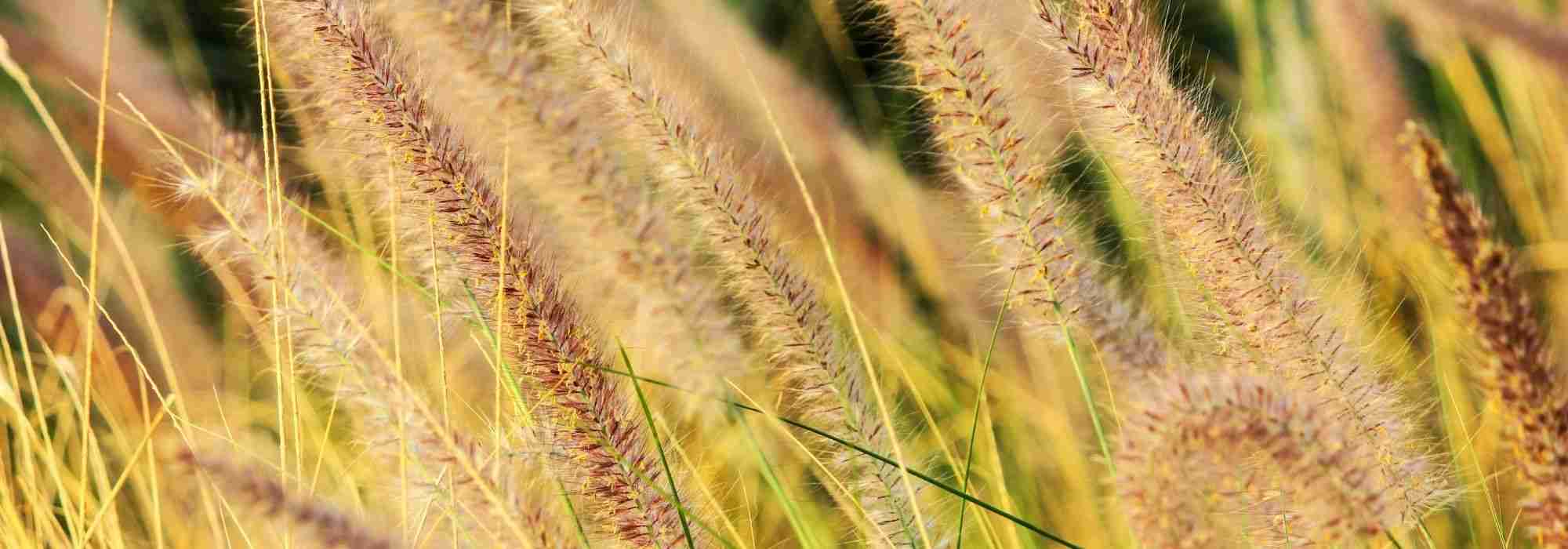
How to design a garden with ornemental grasses?
What parameters should be considered? How should they be arranged and associated?
Contents
Ornamental grasses have, over the past few decades, gained recognition. Far from being regarded as mere “herbs”, they now play a leading role in landscaping. It’s easy to see why they are so appealing. Their habits, shapes, colours, and flowerings are all ornamental elements, and many gardeners have realised this, especially since they are easy plants to grow and live with. It makes sense that they are included in the composition of borders and are increasingly integrated into gardens. However, it can seem challenging to know which ones to select, how to arrange them, and what to pair them with. Therefore, I propose a brief overview to better understand these beauties and to be able to use them effectively. With these few tips, creating a grass garden will have (almost) no secrets left for you!
Why creating a garden with grasses?
Ornamental grasses (and some so-called “gramineous” perennials) offer numerous advantages that few other plants can match. All these qualities provide excellent reasons to incorporate them into a garden:
- These “herbs” are very easy to grow, low-maintenance, and adapt to many types of soil
- They are mostly hardy, allowing them to thrive in gardens across almost all climates
- They require very little maintenance and are almost never diseased
- Mostly perennials, they are very long-lived and serve their decorative purpose for many years
- They are decorative for a long time, nearly 10 months out of 12 for those with deciduous or marcescent foliage, and all year round for the evergreens
- They offer a beautiful diversity in terms of their sizes, habits, colours, and the shapes and hues of their spikes.
- Very versatile, their uses are almost endless: lightening borders by accompanying perennials and bushes, structuring space, delineating areas of the garden, serving as screens, or being used as solitary specimens… their only limit seems to be the gardener’s imagination!
The only caveat to creating a garden of decorative grasses concerns those who have an allergy to these plants. Some produce fewer spikes, and although this may be visually disappointing, it is always possible to cut the inflorescences before they bloom, allowing one to enjoy the beautiful foliage they have to offer.
Read also
9 grasses for dry soilGrasses of various sizes
Not all ornamental grasses are alike. Some remain low and serve as groundcover, such as Carex or Fescues, which rarely exceed 30 to 40 cm in height. Others are much taller and can reach 2 or 3 m, like Miscanthus giganteus or the Giant Reed. Many exist in intermediate sizes, allowing for the creation of different “nival zones” of vegetation by placing the smallest in the foreground (they work wonders as borders), the medium ones just behind, and finally the largest at the back of the bed. However, be careful not to fall into caricature: to add more movement and naturalness to your bed, don’t hesitate to create “breaks,” formed for example by low grasses that dip into the bed between taller plants. This adds rhythm, creates surprises, and avoids monotony.
Most grasses are referred to as “tufted,” meaning they thicken year after year while remaining in tidy clumps. However, there are also running varieties, whose wandering rhizomes move away from the base to emerge a little further away. Ideal for greening difficult-to-access areas or the banks of a water body, or for stabilising a slope, their behaviour can pose problems in a more organised bed, as they may outcompete some of their less vigorous neighbours. It is important to use them with full awareness of their characteristics.
Some low grasses
Carex, Fescues, Hakonechloa, Luzules, Ophiopogon, Stipa (Stipa gigantea can send its spikes up to nearly 2m, but they allow the view through and the foliage remains low)
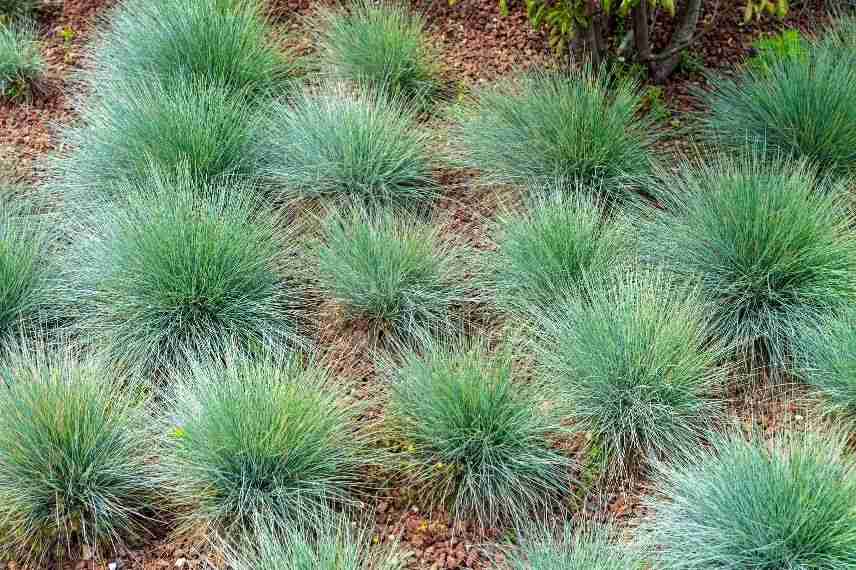
Festuca glauca
Some medium grasses
Sand Reed, Andropogon ‘Purple Konza’, Calamagrostis, Tufted Hairgrass, Cortaderia ‘Pumila’ or C. ‘Splendid Star’ (two “dwarf” Pampas grasses, suitable for small gardens), some Panic grasses, Pennisetum, Leymus arenarius, Molinia ‘Edith Dudszus’, Muhlengergia rigens and M. capillaris, Schizachyrium, and some Miscanthus (which range between 1.2m and 1.6m).
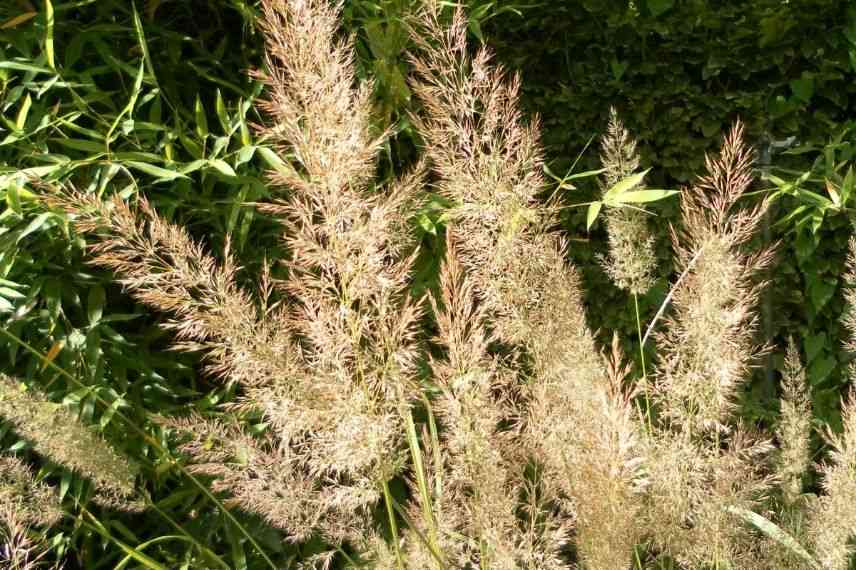 Calamagrostis brachytricha[/caption>
Calamagrostis brachytricha[/caption>
Some tall grasses
Ampelopsis mauritanicus, Arundo donax (as well as its variegated variety), Pampas Grass (there are, however, small cultivars), Molinia ‘Windsaule’, ‘Skyracer’ or ‘Transparent’, Pennisetum macrourum, Phragmites australis, Stipa gigantea (for its long flower stems), Chionochloa conspicua, and many Miscanthus (the tallest being Miscanthus giganteus).
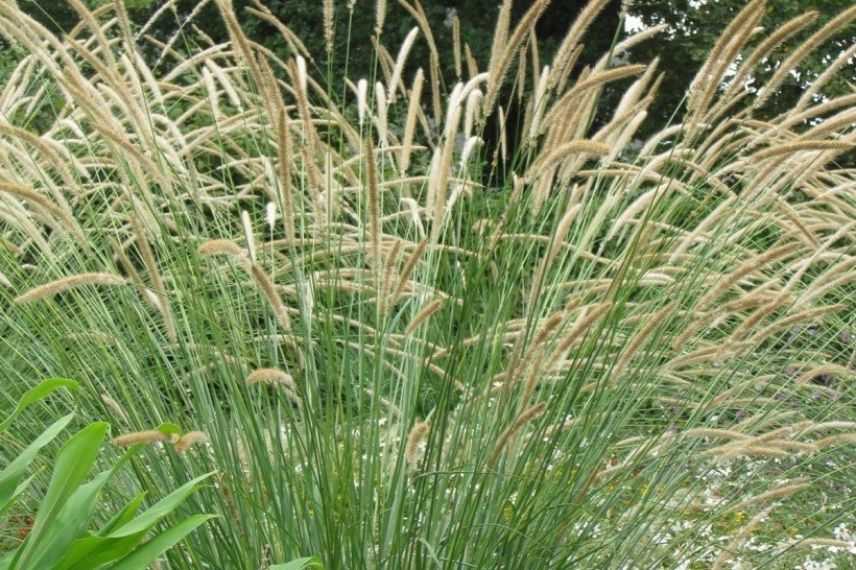 Pennisetum macrourum[/caption>
Pennisetum macrourum[/caption>
→ Read also: XXL Grasses: must-have varieties to add volume to your beds.
Some grasses with a running character
Phalaris arundinacea (especially the type species and in moist soil), Glyceria maxima ‘Variegata’ (in moist soil), Leymus arenarius, Miscanthus sacchariflorus (moderately running), Phragmites australis, Arundo donax, Carex morrowii. One can mention Miscanthus ‘Purpurascens’ (not truly running, but its clump can spread somewhat chaotically), Imperata cylindrica (can spread in moist soil… or refuse to grow elsewhere), or Zoysia tenuifolia (an interesting alternative to lawn, but may require some control).
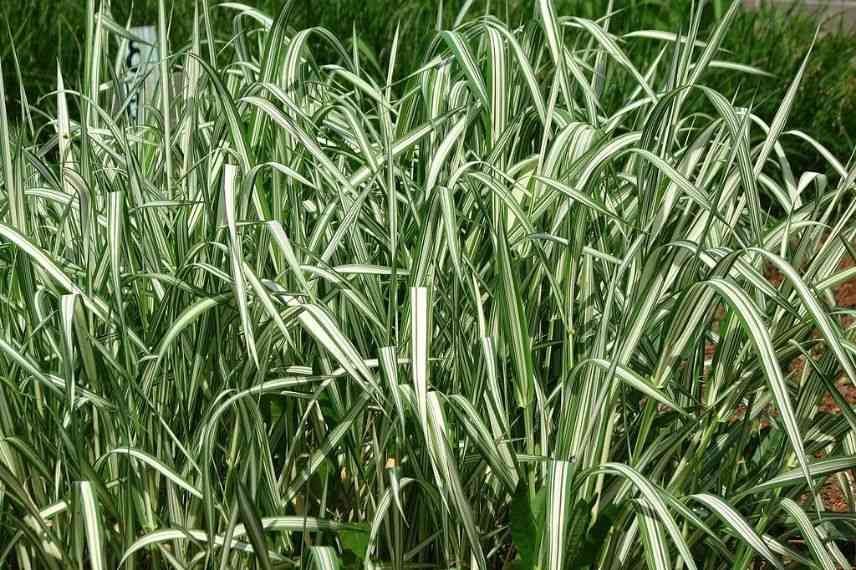 Phalaris arundinacea ‘Picta’ (photo koran)[/caption>
Phalaris arundinacea ‘Picta’ (photo koran)[/caption>
Discover other Ornamental grasses
View all →Available in 0 sizes
Available in 1 sizes
Available in 0 sizes
Available in 0 sizes
Available in 0 sizes
Available in 1 sizes
Available in 0 sizes
Available in 1 sizes
Available in 1 sizes
Available in 1 sizes
Various forms and silhouettes
If dimensions are important for the balance of a planting scheme, habit is just as crucial. Some grasses stand tall and remain perfectly upright, without losing their grace. Their silhouette, which brings structure and simplicity, can be utilised in a minimalist or contemporary design, but they also fit well in more naturalistic or romantic arrangements. They are then accompanied by other grasses with a much more spreading silhouette, creating depth. Some have culms that grow straight but whose tops flare out, resembling a fountain, such as Miscanthus ‘Gracillimus’. Others, like Pennisetum, form a clump with a rather rounded silhouette right from the ground. The way grasses carry their inflorescences can also be advantageous. Sometimes, the spikes are held by straight stems well above the foliage (Ampelodesmos mauritanicus and Deschampsia cespitosa are two examples). Others prefer to develop their flowering in line with their foliage, making the distinction less pronounced. To see this, one only needs to observe a Calamagrostis ‘Karl Foerster’ or a Panicum ‘Shenandoah’.
Some upright grasses
Andropogon, Calamagrostis, Panicum, Festuca ovina, Molinia, Schizachyrium.
Some spreading grasses
Pennisetum, Carex, some Miscanthus, Hakonechloa.
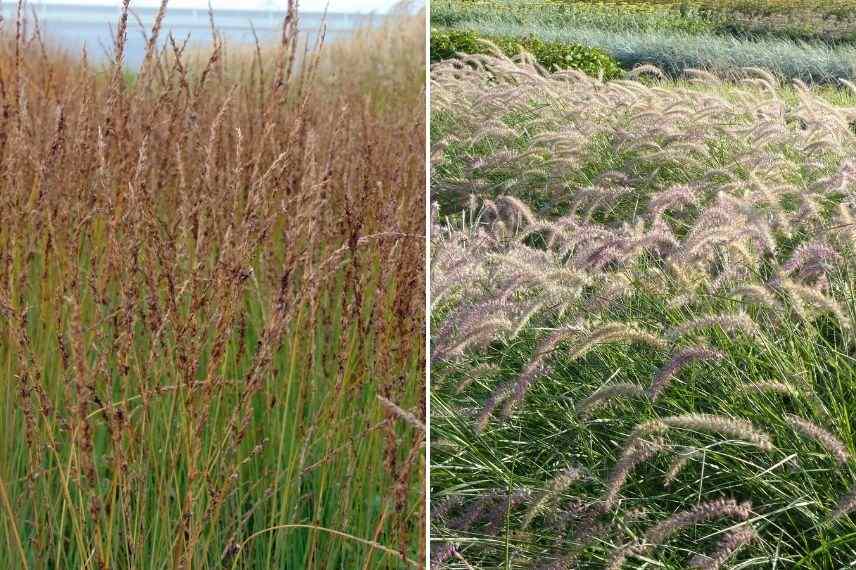
Molinia caerulea ‘Moorhexe’ with an upright habit and Pennisetum orientale ‘Karley Rose’ with a trailing habit
Read also
Grasses: which variety to choose?Varied and colourful foliage
Grasses offer a beautiful diversity when it comes to foliage. As with any landscaping project, a grass garden also plays with the shapes of leaves and their hues. The very fine foliage of an ornamental oat is indeed different from that of a Carex ‘Shima Nishiki’, whose much broader leaves resemble bamboo, or compared to that of a Provence cane. Combining fine and broader foliage allows for depth in a display, with each plant enhancing its neighbour. While this contrast in foliage is interesting, the palette is further enriched when it comes to hues. While many grasses are green (and even within this colour, there are nuances), others boldly embrace colour.
Thus, one can easily introduce touches of blue with candidates such as Helictotrichon sempervirens or Festuca ‘Intense Blue’.
Bronzes, reds, and purples are well represented by cultivars such as Carex ‘Bronze Form’, Imperata ‘Red Baron’, and Pennisetum ‘Rubrum’.
Have fun with oranges (Carex ‘Prairie Fire’), blacks (Ophiopogon ‘Nigrescens’ is a perennial, but its foliage resembles that of a grass), yellows and golds (Carex ‘Aurea’, Pennisetum ‘Hameln Gold’, or Deschampsia ‘Tatra Gold’ to name a few), not forgetting variegated foliage, which is widely represented, including Calamagrostis ‘Overdam’, Carex ‘Aureovariegata’, Holcus ‘Albovariegatus’, or Miscanthus strictus… and the list goes on. Even though these hues are softer than those offered by some bushes or perennials, be careful not to muddle the message or tire the eye by excessively mixing combinations. An association of just 2 or 3 hues can sometimes look much more stylish than a hodgepodge with a kaleidoscopic effect.

Helictotrichon sempervirens (photo Declangi), Imperata ‘Red Baron’ and Ophiopogon ‘Nigrescens’ (photo Wikipedia)
Beautiful flower beds all year round
A garden can be enjoyed all year round, regardless of the season. To achieve an interesting visual effect 12 months a year, it is essential to select grasses that are more appealing at different times of the year.
Evergreen foliage ensures a permanent presence, providing the framework and structure of the bed. This is true for shrubs, for example, and grasses are no exception. Thus, Oat, Tufted Hair Grass, Pampas Grass, Fescues, and many Carex are among those that dress the displays all year round.
While some grasses lose their foliage entirely or nearly so in winter, others retain their dried foliage, which often takes on straw-like hues. They then contrast with those that have evergreen and always colourful foliage. Among them (but they are not the only ones), we can mention Miscanthus or Stipa, whose silhouettes are enhanced by frost, snow, or low sunlight.
Many grasses literally ignite in autumn, offering warm colours in the late season. How can one resist the reddening foliage of a Miscanthus ‘Ghana’, the orange hues of a Molinia ‘Heidebraut’, or a Hakonechloa ‘Nicolas’, or be almost hypnotised by the mixed hues of a Panicum ‘Heiliger Hain’?
The majority of grasses develop their spikes between late summer and autumn, but there are earlier varieties that help bridge the seasons and thus evolve the visual aspect of your bed. Stipa gigantea, Elymus magellanicus, and Pennisetum massaicum (Michael and Olivier introduce them to you in a video) are among these early grasses that enliven your beds from late spring or early summer.
Adapting your choice to the exposure
While many grasses thrive in full sun, where they express their full potential, it is entirely possible to create a border of grasses in partial shade or shade. To achieve this, you simply need to select those that are not disturbed by such conditions, or even prefer them. Among the best candidates, note that many Carex enjoy less bright situations, just like Hakonechloa, Hystrix patula, Luzules, Ophiopogon, or even Phaenosperma globosa (a rather obscure grass).
With a few hours of sun in the early or late day, several others also perform wonderfully and complement the gardener’s palette, provided they are given soil suited to their needs.

Hakonechloa macra ‘Aureola’, Hystrix patula and Luzula sylvatica ‘Marginata’ (photo Guido)
Provide suitable soil
The right plant in the right place” is a well-known saying among gardeners. While exposure is important, the nature of the soil may be even more crucial for a plant’s survival and healthy development. A well-drained yet consistently moist soil is always appreciated by gramineous plants and ensures a more generous spike, although some are content with drier conditions. Conversely, others thrive only in genuinely moist or even wet soils, without which they may struggle or even disappear. Before you start, consider checking this element to save money and limit disappointments.
- Among the ornamental grasses for dry and warm soil, you can mention Stipa calamagrostis, Bouteloua gracilis, Muhlenbergia capillaris and M. rigens, Schizachyrium, Sorghastrum nutans, Stipa, and Fescue.
- In a selection of grasses for wet ground, you can also consider Alopecurus ‘Aureovariegatus’, Provence canes, the common reed, Acorus (a perennial gramineous plant), as well as many Carex.
Grasses alone or accompanied?
Grasses offer numerous ornamental advantages, which may encourage some gardeners to create beds exclusively composed of these plants with varied shapes and colours. However, in nature, it is not uncommon for a few perennials to join the dance, such as Violets in spring, Lupins, Echinaceas, or Limonium in summer, and Asters and Helianthus in the late season.
Integrating shrubs and perennials adds colours that grasses cannot provide, whether through their foliage or their flowering. Similarly, the foliage of grasses is often quite similar due to their long, slender shapes. Perennials and shrubs allow for interesting contrasts. Not to mention that melliferous and nectariferous flowers attract numerous pollinators and beneficial insects, which in turn invite birds to come and feed. Certain plants (due to their habit or structure, for example) help create a bed or garden with a distinct style and atmosphere. I suggest a few ideas based on the desired effect, but this list is far from exhaustive. Feel free to adapt it to your tastes!

Grasses in a contemporary garden
Opt for plants with a strong or minimalist graphic design. Decoratively barked trees and shrubs such as Birches or certain Prunus pair well with grasses, both in summer and winter. Plants with a naturally rounded habit, or trimmed into topiary, create a beautiful interplay of shapes with the lightness of grasses. Boxwood, Pittosporum, Eleagnus, Lonicera nitida, Hornbeams, or even Yews lend themselves well to this game. Arrange the plants in organised groups or repetitive patterns to further enhance the formal aspect of the composition.
For perennials, Acanthus, Ferns, Cimicifuga, Delphinium, Eryngiums, Kniphofia, Perovskia, Verbascum, or Buenos Aires Vervains are already a good starting point.
You can also incorporate bamboos, which are also part of the grass family, ensuring to choose clumping species or containing the more spreading types with rhizome barriers.
Naturalistic gardens and grasses
Naturalistic gardens resembling meadows (falsely wild) are very much in vogue. Highlighted by landscape designer Piet Oudolf, they heavily utilise grasses, mainly associated with perennials. Among them, we can mention Persicarias, Achilleas, Sedum, Eupatoriums, Thalictrum, Helenium, Echinaceas, Actaea, Sanguisorbas, and Monardas, which are among the classics used in meadows. Install them in swathes to create blocks of colour and shape, ensuring to plant the tallest towards the centre of the bed (if it can be viewed from all sides) or at the back (if it is against a hedge or building).
Romantic garden, grasses as support
A romantic garden or English mixed-border often features grasses that infuse movement, grace, and poetry. Roses naturally play a leading role in this type of garden, as do certain perennials, which sometimes have a somewhat old-fashioned charm. Phlox, Nepeta, Hardy geraniums, Campanulas, Digitalis, Astrantias, Sages, Peonies, Dianthus, Daylilies, and Gauras are almost indispensable. For shrubs, you can incorporate Hydrangeas, Lilacs, Buddleia, or Camellias, which enrich the scenes throughout the seasons. Finally, use climbers like Clematis, which bloom at different times of the year depending on the species.
A grass bed for autumn
Grasses are generally at their best in the late season. What could be better than plants with warm hues at the end of the season to accompany them? Liquidambars, Tulip Trees, large Maples, certain Oaks, and Ginkgo are better suited for large spaces (unless choosing dwarf varieties). For small gardens, turn to Japanese Maples, Cotinus, Hydrangea quercifolia, Winged Euonymus, Decorative Dogwoods, Crape Myrtle, or Viburnums, which are reliable choices. Then, all you need to do is complete with late-flowering perennials such as Asters, Sedum, Japanese Anemones, Ceratostigma, Chrysanthemums, Persicarias, or certain Sages.
Whatever type of grass garden you create, don’t forget to install groups of spring-flowering bulbs, which offer their colours while the deciduous species have been cut back, and which then remain well hidden under their new foliage for the rest of the year.
- Subscribe!
- Contents
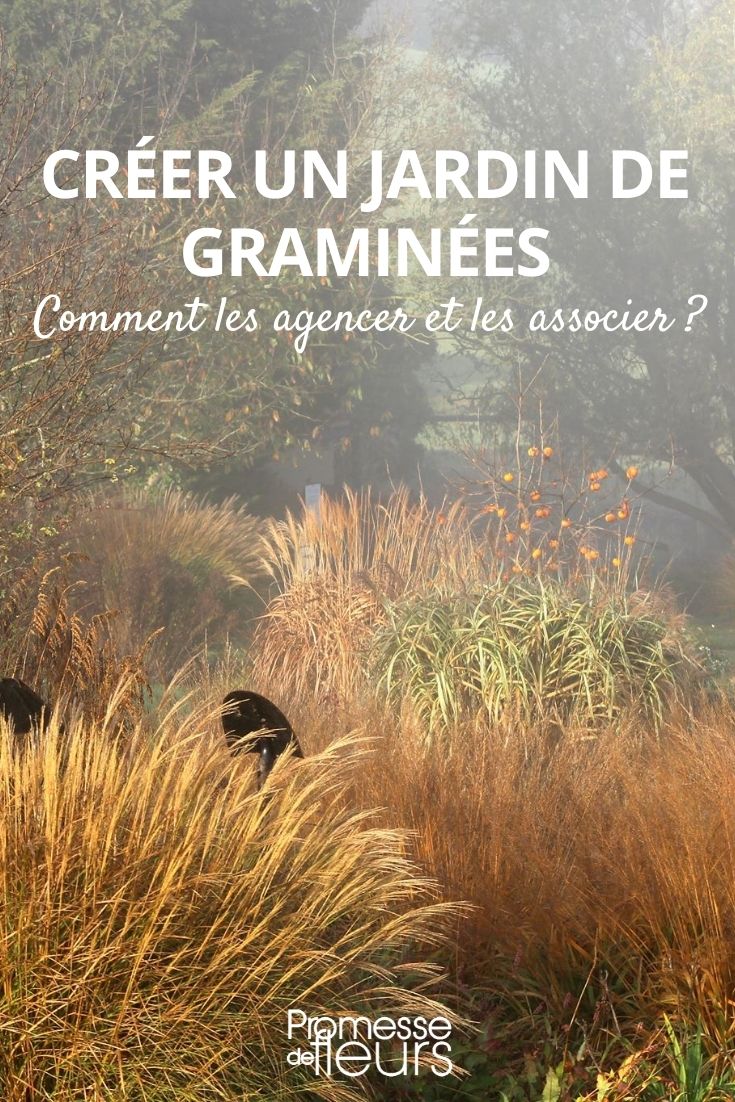
































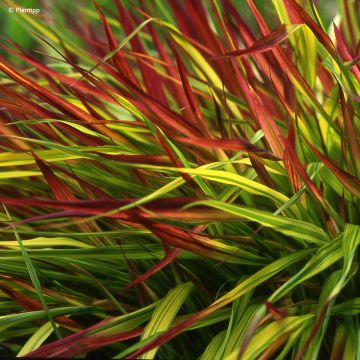
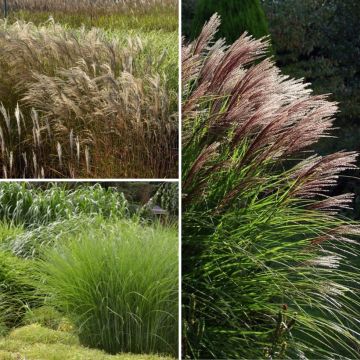
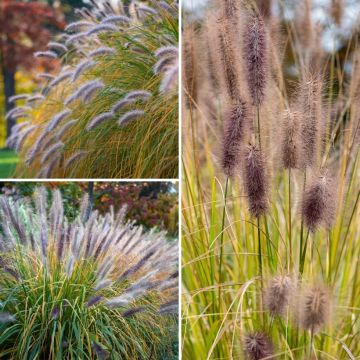
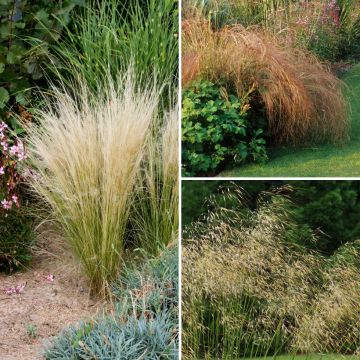
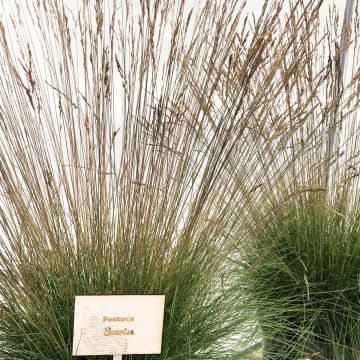
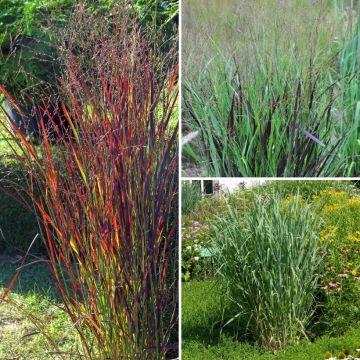
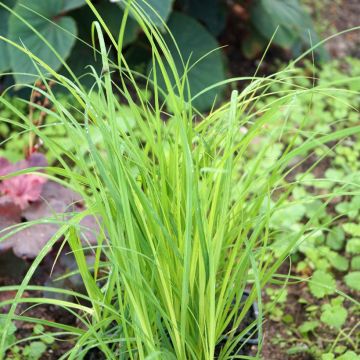

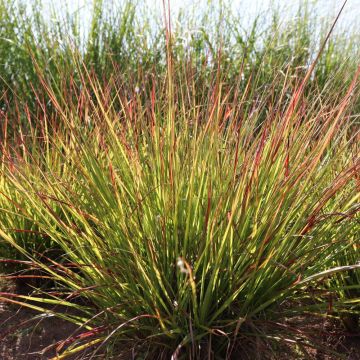
Comments